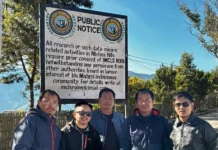[ Tongam Rina ]
ITANAGAR, Jan 27: The National Tiger Conservation Authority (NTCA) has said that the Arunachal Pradesh government needs to be more serious about the regularization of the jobs of the State Tiger Protection Force (STPF) personnel and forest guards.
Speaking to The Arunachal Times, NTCA Inspector General of Forests, HS Negi, said there is a “severe shortcoming” in the forest department as it has not been able to appoint new guards or regularize the jobs of the STPF personnel even though the NTCA has been constantly supporting the government by providing funds.
“The STPF and forest guards should have been raised a long time ago as we have been constant in giving funds to the government. There is an urgent need for recruited staffers,” Negi said.
If the government prepares a proposal, including ration for the STPF staff, the NTCA will take the necessary steps, Negi said, and expressed displeasure over the parking of the funds by the state government.
Negi said it would be impossible to secure the tiger reserves in the state with such few frontline staffers.
“Each guard has to patrol 50 square kilometres, which is humanly impossible,” Negi said.
He said the government should recruit only people who genuinely understand the forests. “We can’t have people who are scared of walking in the forests,” Negi said.
Global Tiger Forum chairman Rajesh Gopal said the state government needs to have “more zeal” towards protection of wildlife and tigers.
He said the state government should recruit as many staffers as needed to safeguard wildlife, adding that the state has topographical advantage and geographical contiguity which have been crucial for the survival of wildlife.
Chief Minister Pema Khandu while addressing the gathering at the Pakke Paga Festival in Seijosa on 20 January promised to create 113 posts in the STPF. He also said that 170 posts of forest guards, along with that of a forester, have been sanctioned, and that recruitment to the posts would be held shortly.
Earlier, in May 2017, the CM had issued specific directives to expedite the establishment of the STPF. However, it appears that the government is caught up in a bureaucratic quagmire as it is yet to start the recruitment process. Even though there already exists the Arunachal Pradesh Forest and Special Tiger Protection Force Act, the frontline staffers have been caught by the inaction of the forest department for years now.
The Centre is also is not happy with the department’s handling of the STPF recruitment.
The Committee on Government Assurances had asked states, including Arunachal, in January 2017 to give written responses regarding their inability to constitute STPFs. Now, with the NTCA insisting on recruitment, it remains to be seen what action will be initiated.
Pakke dependent on daily wagers
The Pakke Tiger Reserve has a contingency of some 170 staffers, including 50 STPF personnel, who are the anti-poaching squad.
They are daily wagers and get lump sum amounts ranging between Rs 7000 and Rs 12000 per month, according to seniority. They do not get ration allowances, unlike the regular staffers, who get Rs 800 per month from the NTCA.
From 2012 till 2018, the Wildlife Conservation Trust provided funds for ration for the frontline field staff. The park and its wildlife inhabitants are dependent on these frontline staffers, who are faced with job uncertainty along with low wages.
Meanwhile, the Namdapha Tiger Reserve, with 1985 square kilometres, is one of the largest parks in the country. However, the park has only about 200 staffers, including 160 contingency staffers.
Relocate people from core area
Regarding relocation of the people from the core area of the Namdapha National Park, Negi said the government was asked to identity the pockets where there are human habitations.
“We have the best possible package, but the relocations have not happened because of lack of initiative by the forest department. If the relocation does not happen, there is bound to the inevitable human-wildlife conflict,” Negi said, and urged the government to fill the gap that exists between the locals living inside the park and the state’s forest department.





